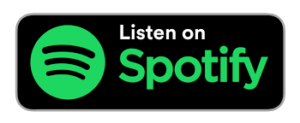Today I’m calling Paul Pfeiffer, an American artist well known for utilizing sophisticated digital technologies to scrutinize the role mass media plays in shaping contemporary consciousness. Born in Honolulu in 1966, Paul and his family spent several years in the Philippines before returning to Hawaii. Paul now lives and works in New York, where he investigates the relationship between video, sporting events, racial politics, and what he calls “spectacle and spectatorship.” Paul, thank you for joining me.
Paul Pfeiffer: Thank you for having me.
[Continue reading for full transcript.]
Transcript
BL. I’ll start by asking, how did growing up in Hawaii and the Philippines shape your outlook on life? In the past, you’ve spoken about your childhood in Manila and Honolulu and this notion of colonial expansion.
PF. I did grow up moving quite a bit between Hawaii and the Philippines. Even before my family moved there in 1976, I was spending summers every year in the Philippines while my parents were teaching and working on research in the Philippines. It was less of a kind of one way round trip and more of something that constituted a continual movement from pretty much shortly after I was born, in a maybe very counterintuitive way.
I graduated high school from a boarding school in New Mexico that otherwise was a boarding school for Navajo kids coming from the reservation. That’s because my family moved from the Philippines to teach at that boarding school, which was called Navajo Mission Academy in Farmington, New Mexico. So, after coming back from the Philippines, I was immediately in high school and finished high school on the Navajo reservation or just off of it.
So, in some ways, as unlikely as that might seem, you could say that that really traces a certain global trajectory of philanthropic missionary activity coming from the U.S. specifically and connecting various former colonies or sites where American political intervention or involvement has been the case for a long time. Maybe the way that influences me or contributes to my own worldview is that, in a sense, I really grew up with a front row seat to the theater of American manifest destiny—the importation of American education to places around the world and, in the case of the Navajo reservation, within it as well.
Given that my parents were musicians—in this context, church musicians specifically—the idea that somehow culture plays a role in the formation and maintenance of official ideologies was pretty self-evident from the beginning. Just the fact of living in the Philippines, where there’s such a long history of a relationship with the U.S., and moving between that and Hawaii, in a way, revealed the outlines of the ideology to be a performance or maybe like a facade—something fabricated. My family is part of that structure that fabricated the ideology of American manifest destiny on a cultural level.
I think of artists like Cady Noland who deal so explicitly with the use of signifiers associated with American mythology, and then hollowing them out, formally speaking, so that they appear like these objects that are literally a kind of facade, that sit in the room broadcasting their hollowness.
The connection I feel towards her work and other artists working in a similar vein, purposefully playing with these very loaded signifiers, and, in a way, hacking into them and using them to reveal the way they work as a sort of ideological facade, maybe describes something. I don’t know where it comes from in the case of Cady Noland, but I identify with what she’s doing in terms of a certain aesthetic use of these loaded signifiers.
BL. I’m curious, I know you did a B.A. and an M.A. And then you did the Whitney Independent Study Program. Did that have a big impact on the politics of your approach?
PF. The Whitney program, and grad school in general, certainly did a lot to create context or a sense of a shared platform for a lot of my information, ideas based on just personal experience. In some ways, I feel like I was late to the conversation in terms of really thinking about my relationship to the general legacy of, say, conceptual art in the U.S. But once I began to focus on it, I pretty quickly realized that I could form a sense of forbears, a shared context with people that I was introduced to through the Whitney program.
In particular, I remember the first time that I focused on the movement known as the Pictures Generation. And the more I thought about it—even though at the time, I think the strategies used by what are classically thought of as the Pictures Generation artists were very different from my own—the more I looked into it, I realized, “Oh, these are people who, for whatever reason, are seeing the same kind of slippage in the signifiers that I feel like I see.”
In my case, I guess what I was saying earlier is I feel like I see that slippage. I can’t help but connect it to my own upbringing, moving between contexts and seeing that slippage happen firsthand. I’m curious how other people come to it, but there’s certainly a sense of shared perspective, in terms of seeing this thing that’s happening.
BL. This takes us very directly to your early work and the idea of erasure as a technique and concept. For your video work from 2000 called John 3:16, which is in the MoMA collection, you painstakingly manipulated and reprocessed 5,000 digital images into a new work, removing the presence of basketball players on the court and leaving only a palimpsest of their hands.
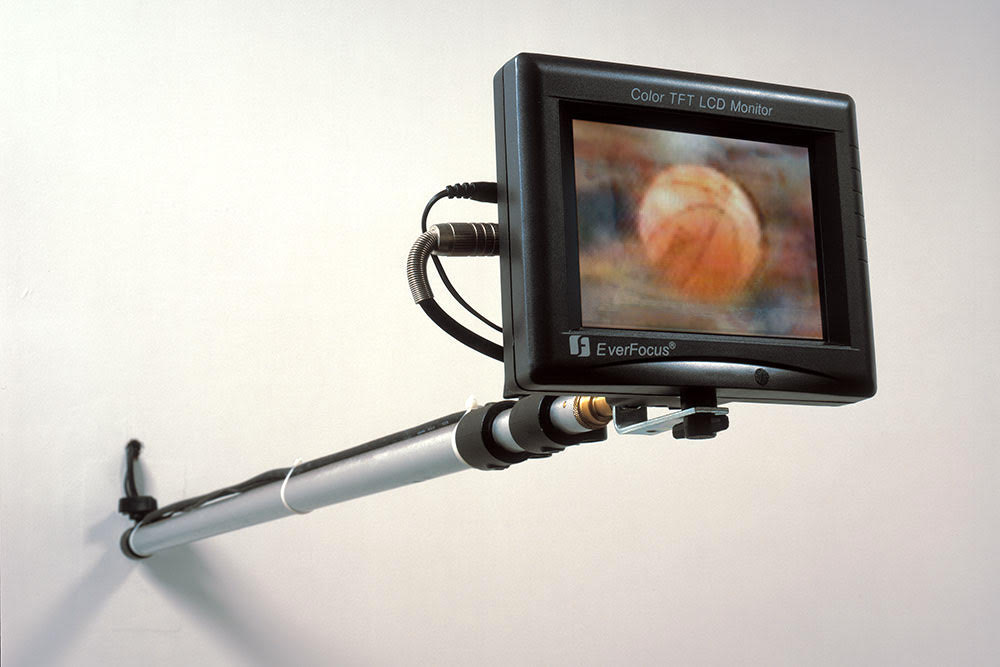
Digital video (color, silent; 2:07 min., looped), LCD monitor, and metal armature
7 x 7 x 36 in. (17.8 x 17.8 x 91.4 cm)
Edition of 3, 2 APs
© Paul Pfeiffer. Photo: Courtesy the artist and Paula Cooper Gallery, New York.
The absence of athletes repositioned what you call “the spectacle and spectatorship,” centering our attention on the gravity-defying basketball, as it mysteriously and miraculously floats in the air. What were you thinking about when you made the work?
PF. Generally, I was thinking about how sports is one of the most familiar scenes in contemporary life, whether you love it or hate it. In fact, it can be polarizing. And yet, for my purposes, it’s less sports itself and more the idea that sports, because of its familiarity, could serve as a kind of broadly familiar portal into a more complex and deeper realm. That was one thing that I was thinking, especially because I wasn’t raised in a family that participated as spectators in sports, generally.
So sports started out as an alien experience to me, and maybe that’s why I felt that it could be productive to take it up as a kind of language to use. In a sense, really, I guess the aesthetic maneuver of centering the ball and displacing the usual stars of the game are very much in line with the way that I was looking at basketball to begin with. It further de-familiarizes this thing which, on the surface, seems to be very familiar. That is done by taking away the storyline in terms of what team is winning or losing and just focusing on this thing that’s more like a prop and giving it the star treatment and making it the center of attention. I was thinking it would serve to formally abstract it in the same way that I was already perceiving it myself, and maybe attempting to find a way to share that same sense of de-familiarized familiar in the scene of sports.
What it was meant to mean was not at all singular in a kind of didactic sense. It was more, in fact, the opposite: The idea that by taking signs that are familiar and purposefully removing the caption or the obvious framing of it, it proliferates the potential meanings of the image and opens it up to become almost like a matrix or like a Rorschach test.
BL. There are two other ideas in there. First, there’s the title, John 3:16, which comes out of the Bible. And second, when we acquired it for the MoMA collection, initially I thought, you have the image of the 5,000 basketballs on a very small screen installed at what, to me, was the basketball hoop height, but I came to understand there was another image in your head, and that had to do with the uplifting height of a religious icon in a church.
PF. Right. Thank you for picking up on that. I would say, generally, this was late ’90s or, specifically, I think it was the year 2000 when the piece was made. The art world was just wrapping its collective brain around the place of moving images in the art context. I remember in that year, 2000, I was in the Whitney Biennial, and I think I was only one of two video artists who had managed to get their work on the main floor with the sculptures and paintings, as opposed to in the theater where they were playing videos on a loop and you’d have to come at a specific time to see it.
To me, that was an indication that major institutions like the Whitney were still grappling with what to do with video within the overall scheme, and from there, I think these new modes of image production have only been integrated further into the curatorial program of all institutions. So, what you’re describing, in terms of the height and the scale of the monitor that the image was meant to appear on, were meant as a departure from what were then the most obvious ways to show video.
Primarily, if you saw a video installation, it tended to be very large projections. To go miniature, although it’s hard to imagine it, at the time was extremely unusual. Now miniature is the predominant format, so it’s hard to remember that that wasn’t always the case. I thought that in some ways the relationship which maybe also applies to what you’re saying about the height of the basketball hoop and the relationship to where a religious icon would be placed. Unlike a large projection, a miniature monitor would almost seem to insist on a kind of individual relationship to the image, whereas in a theater, the anticipation is of a crowd of viewers. Where with a miniature screen, you have that same, formally speaking, expectation of a one to one relationship, but that relationship of the viewer to the image as like a one to one intimate relationship to me is important.
BL. We’ll move on to your sound-video installation, which is very interesting to me. Your 2007 work, The Saints, premiered in Wembley, England. You took sounds of the crowd from the very famous 1966 World Cup final played between England and Germany. It was the most famous sporting event ever staged in Britain. You took the sounds of the crowd cheering and chanting and praying. You mixed those with voices that you recorded in Manila of a crowd of young Filipinos who chatted and cheered their way through the soundtrack of 1966.
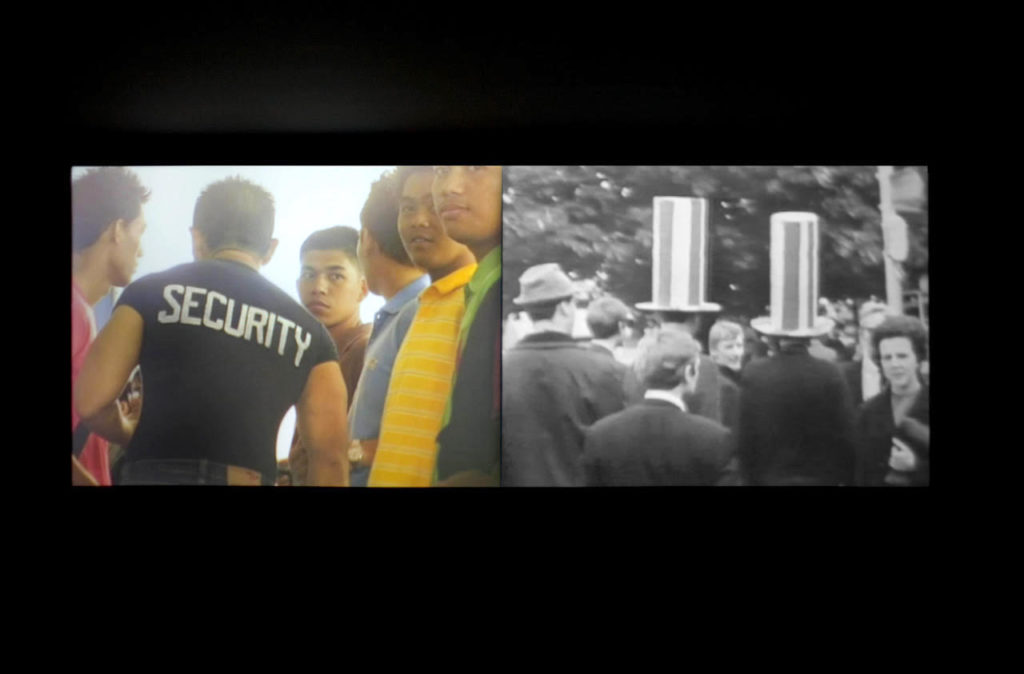
Seventeen-channel audio, two-channel video loop with stereo audio; single-screen video loop, cast armature with LCD monitor
Installation view, The Saints, Nationalgalerie im Hamburger Bahnhof – Museum für Gegenwart, Berlin, Germany, October 10, 2009 – March 28, 2010.
© Paul Pfeiffer. Photo: Courtesy the artist and Paula Cooper Gallery, New York.
Vimeo: https://vimeo.com/134601349
The installation consisted of a large constellation of speakers that played the soundtrack to a phantom spectacle. You were in England with a commission from Art Angel, the London-based organization that collaborates and produces large scale new work by artists. What was important to you about the history of Wembley and premiering the work at that location?
PF. Following the same logic, the interest behind the 1966 World Cup is because of all of the psychic weight that it carries on many different levels, and certainly, it would be another case of where I don’t even need to apply a religiously loaded title to the situation. The title, The Saints, came from “When the Saints Go Marching In,” [the black spiritual,] which is the official anthem of the English national football team.
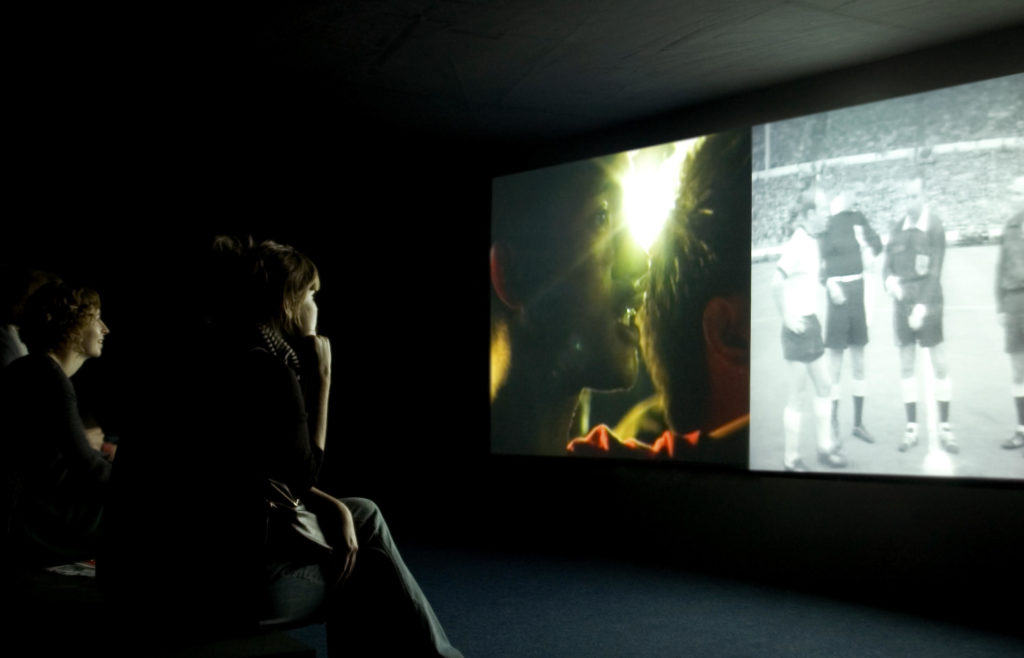
Seventeen-channel audio, two-channel video loop with stereo audio; single-screen video loop, cast armature with LCD monitor
Installation view, The Saints, Nationalgalerie im Hamburger Bahnhof – Museum für Gegenwart, Berlin, Germany, October 10, 2009 – March 28, 2010.
© Paul Pfeiffer. Photo: Courtesy the artist and Paula Cooper Gallery, New York.
Wembley Stadium itself, which dates from the heyday of Victorian England, is almost emblematic of the British Empire. It was literally built as part of the World Exposition campus, built for the world fairs that happened in the 1800s to really spread the word about the ascendancy of the British Empire, and from the beginning, from the first game that was played in Wembley Stadium, games at that time, always began with the singing of religious hymns, like specifically that beautiful anthem called “Jerusalem,” which at one point was considered to be potentially the national anthem of England but was rejected in favor of something a little bit less explicitly Christian.
The song “Jerusalem” is built around the words in the poem, Jerusalem by William Blake. And somebody [Sir Hubert Parry] put them to one of the most amazing kind of, an unusual kind of hymn-like melody. That was why the choice of the text of the 1966 World Cup. It’s already loaded with all of these resonances and nuances, again, almost like a matrix. The point was really to tap into a certain kind of psychological world associated with the nation state of England, but played out on the battlefield of the football match, and this particular match being against West Germany, just twenty-five or less years after the end of World War II, made it even more of a loaded situation or text.
Similarly, in some ways, the idea to reproduce the sound of the crowd singing English national anthems and chants, as well as German fans singing the German national anthem and similarly nationalistic German chants, and to reproduce these sounds using a crowd of a thousand non-actors in a movie theater in Manila was mined specifically for its nonlinear character. There’s very little historic relationship between England and the Philippines, certainly much less so than, say, between the Philippines and the U.S. or Spain.
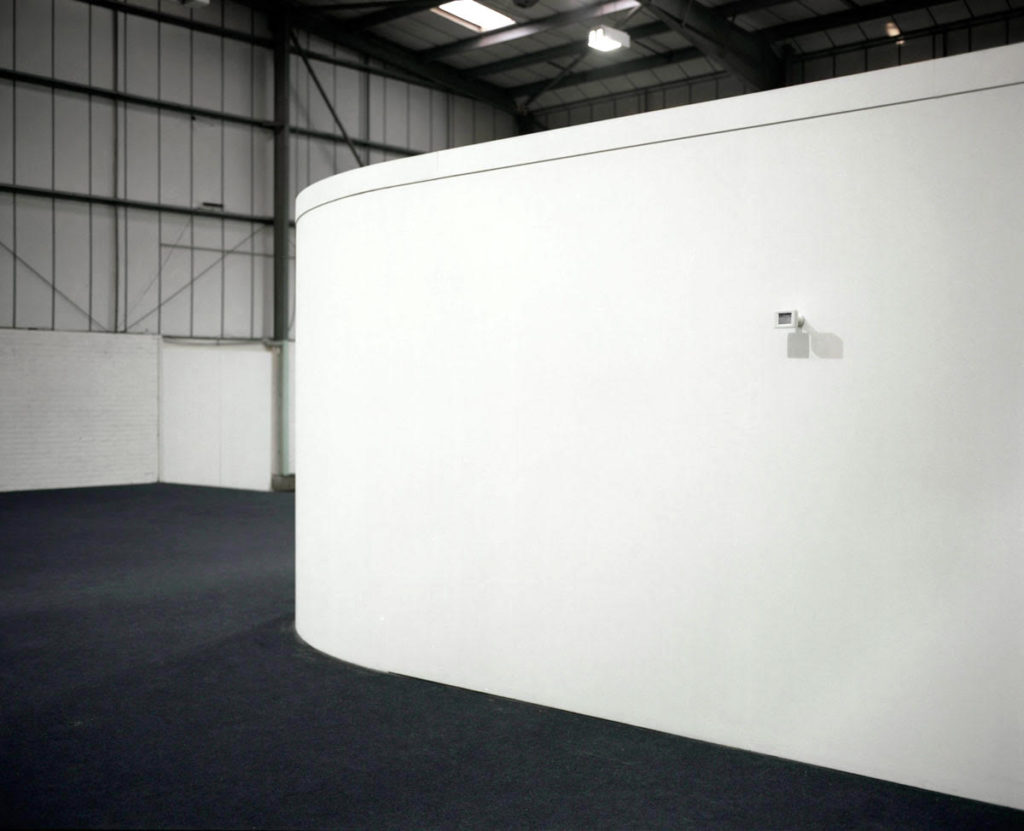
Seventeen-channel audio, two-channel video loop with stereo audio; single-screen video loop, cast armature with LCD monitor
Installation view, The Saints, Nationalgalerie im Hamburger Bahnhof – Museum für Gegenwart, Berlin, Germany, October 10, 2009 – March 28, 2010.
© Paul Pfeiffer. Photo: Courtesy the artist and Paula Cooper Gallery, New York.
England played a very minor role, but very minor. The choice to reproduce the sounds in that specific context were meant to raise the question, why? Or to cut through the self-evident nationalistic meaning of the anthem’s text and to shoot it through with this element that would seem to contradict it.
BL. This takes us right into a recent work of yours. You were the Lamar Dodd artist-in-residence at the University of Georgia, in Athens, Georgia, from 2016 to 2018. I would love to hear a lot more. During your research at the school you focused not on the student athletes, which one would think would be natural, but you focused on the Redcoat Marching Band, and on what you call the sonic amplifier of crowd affect and ritual. What was it about the band’s performance that inspired you to use them as a lens to see the history of the American south?
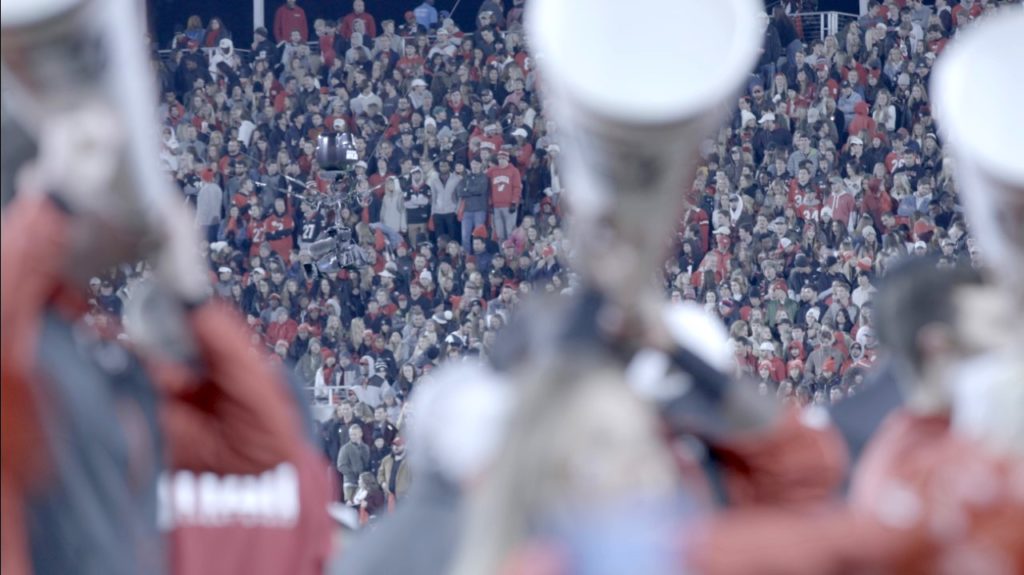
Performa Commission
Co-Commissioned with VIA Art Fund for the Performa 19 Biennial
Photo © Paula Court. Courtesy the artist and Paula Cooper Gallery, New York
PF. To me, it was very apparent from the beginning that there’s a kind of psychic imaginary around the south in American culture, particularly for those of us who are based in the north. The south looms large as a kind of almost like an antithetical version of civil society in the north. So, I guess for me, it was the relationship between that history and then college football being particularly associated with the southeast.
The Southeastern Conference of College Football (SEC) is one of the most popular franchises in college football. And the University of Georgia is one of four colleges in the entire American nation that occupies the top level of college football, along with Ohio State, and others [Alabama and Clemson]. So, you couldn’t get more into college football than University of Georgia Bulldogs. I had never been. I basically accepted this really great invitation from folks in the art department at UGA, who had invited me to do a lecture there over ten years before, and they had me on their list of people to invite back.
In 2016 I accepted and was given this really amazing opportunity to be on campus for a full year. I got them to extend it to the max, to two and a half years. I used that time generally just to live and experience what it was like to be Georgia in the 2010s, and specifically, at a football school that goes back generations. Once again, I found myself in the stadium during my first game having zero idea of what was going on the field. But I was just attracted to the whole scenario.
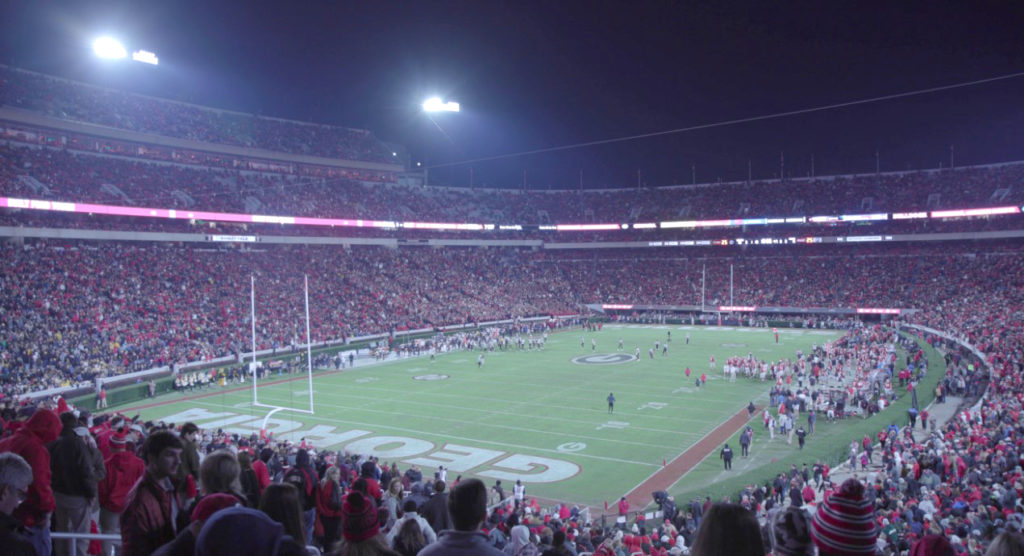
Performa Commission
Co-Commissioned with VIA Art Fund for the Performa 19 Biennial
Photo © Paula Court. Courtesy the artist and Paula Cooper Gallery, New York
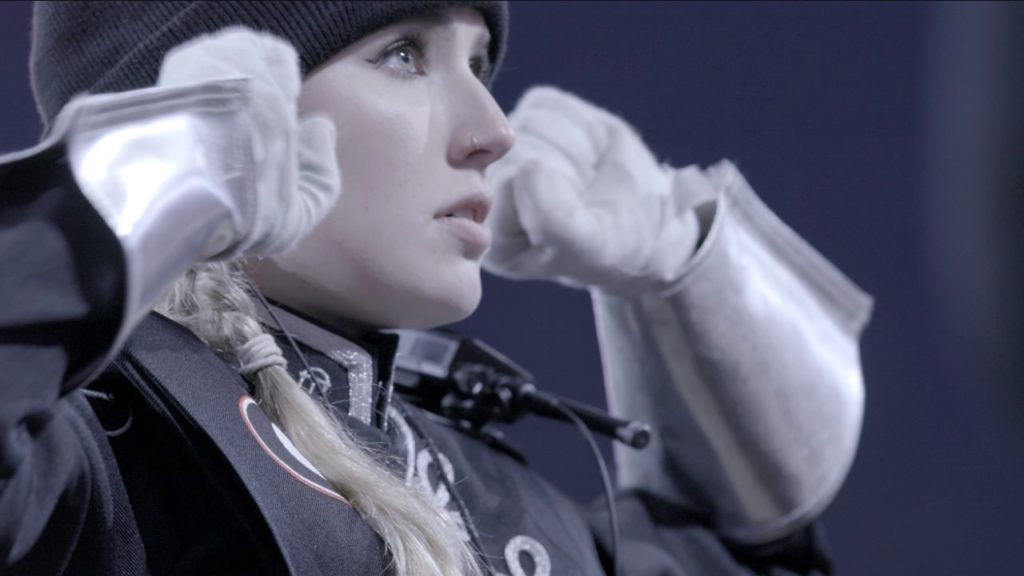
Performa Commission
Co-Commissioned with VIA Art Fund for the Performa 19 Biennial
Photo © Paula Court. Courtesy the artist and Paula Cooper Gallery, New York
A crowd of close to 100,000 people filled the stands, and they all were wearing red, so it was very spectacular. I expected to be looking at the field but I was drawn immediately to this shiny object that was sitting in one corner of the stands. That was the band, all in their red uniforms with the sun glinting off of their chromed instruments, and they’re all moving in unison. Really what I didn’t expect is that they performed during the game, not just the halftime maneuvers on the field.
I found the halftime less interesting, which was more expected. The fact that throughout the game, minute by minute, they were reflecting what was happening on the field with a selection of songs that were either booing a bad call from the referee or celebrating that they just made a goal, a touchdown. There were songs that served to accompany every different action taking place on the field, and in a way to musically symbolize what was happening.
You could basically decode what was happening, just by what the band was playing. It wasn’t just a band, because, really, what the band ends up being is a trigger for the entire crowd. Really the band is only one part of a call and response that’s happening throughout the game between the band and the crowd. The crowd, as it turns out, knows all the songs that the bands will play. I think there’s something like a total of just over one hundred different songs in the band’s repertoire, and it changes from season to season.
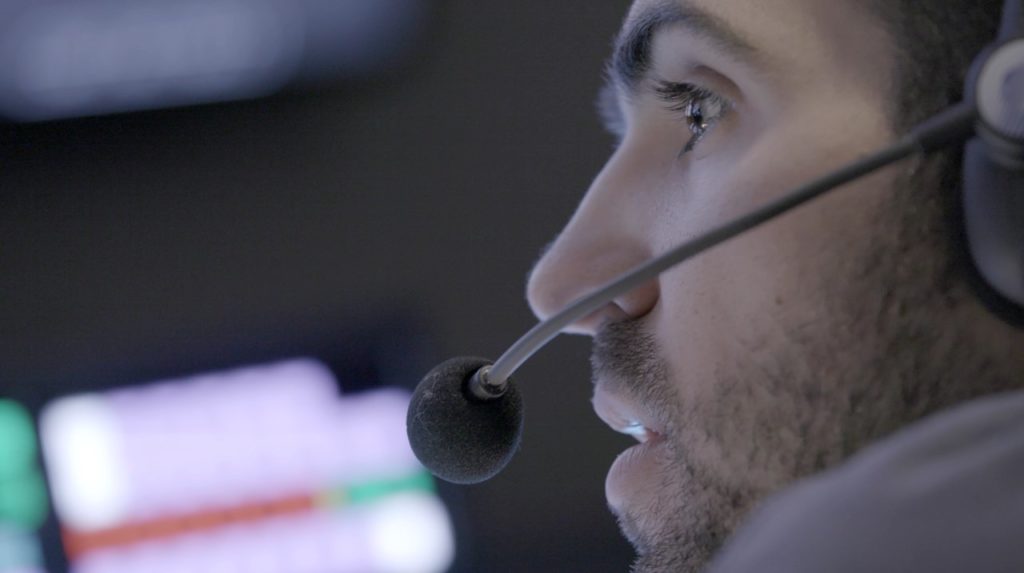
Performa Commission
Co-Commissioned with VIA Art Fund for the Performa 19 Biennial
Photo © Paula Court. Courtesy the artist and Paula Cooper Gallery, New York
The majority are old standbys, and what I came to realize as I delved more deeply into it is that none of it is arbitrary. Everything is choreographed down to the finest detail. In fact, there is a specific song for the first down, for the second down, for the third down, for the touchdown, for the foul. Everything is ritual and everybody in the stadium knows it. I also just found out relatively recently that one of the first things every incoming class of freshmen does when they come on campus is, they’re taken into the stadium and they’re given a songbook with all of the songs, and told study it, and then come back for the games when they’ve learned the songs and know what to sing and shout at the right moment.
It’s really that ritualized and choreographed. And yet, obviously, it’s abstract, for me to turn the cameras away from the field and only focus on the band. In the end, it provides a similar experience to my taking the image of a basketball game and removing the players. It takes something that’s utterly familiar, by definition, and in a way, purposefully inserting a gap of signification to produce a kind of otherness. Because in fact, if you turn the cameras like we did, away from the field, and focus only on the crowd, then what you discover is that because of the rules of college football, they never get to complete a song.
Their performance is characterized by the strangest rhythm of starting and stopping songs. The reason has to do with the SEC [Southeastern Conference] guidelines. A football a team like the Bulldogs would be penalized if their band plays while the ball is live. They can only play when the ball stops, so they train themselves every year how to stop on a dime. It’s part of the essential toolkit of what they do. In a strange way, you have encoded a lot of history in the band, especially, given that really the origins of the band would be the band in an actual battle and would have been the front guard, to spare the emotion of the soldiers when they’re running against the opponent.
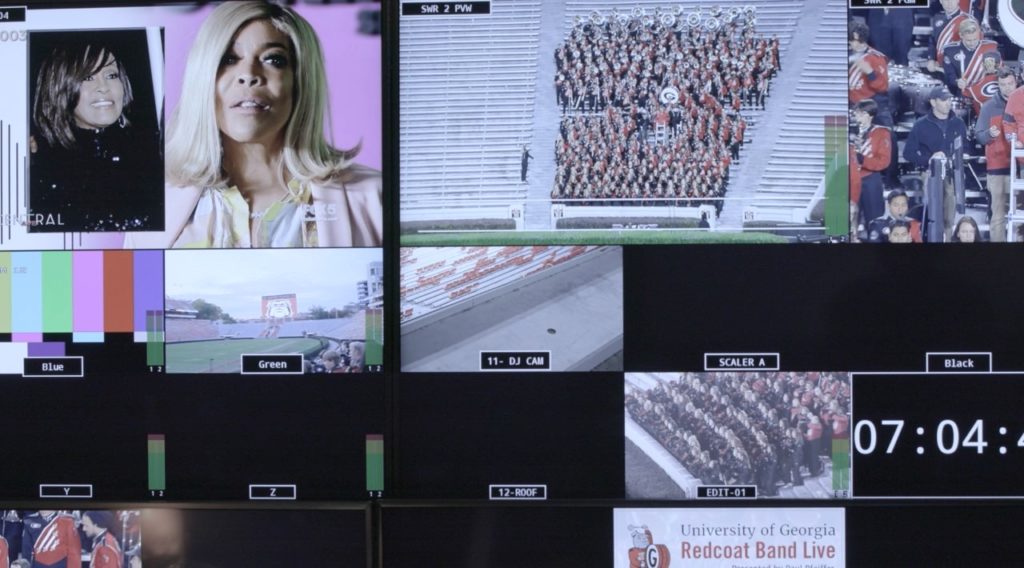
Performa Commission
Co-Commissioned with VIA Art Fund for the Performa 19 Biennial
Photo © Paula Court. Courtesy the artist and Paula Cooper Gallery, New York
So really, the band is nothing but the history of the Civil War, but then, to treat it in a certain way, to remove the caption of the sports commentary of the game reveals it to be this strange performance with a lot of otherness in it. It’s like the Star-Spangled Banner, but constantly starting and stopping.
BL. There was long research phase, when you spent a lot of time thinking about the band. The piece was a commission for a Performa 19. I believe eventually the work will be an installation, as well. But as a performance and simultaneous live stream broadcast, it was very interesting that fifty of the band members came to the Apollo, the other three hundred were back in Georgia. The performance happens to have been on Veterans Day, the only day of the year that stadium doesn’t have a game.
You were interested in the choreography of the game structure, the band playing, and then you had to structure everything around it. You were in New York. Part of the performance happened in the Apollo Theater, which is also loaded with history. Please tell me a little bit about how you structured what was at the Apollo. Was it a very complicated work?
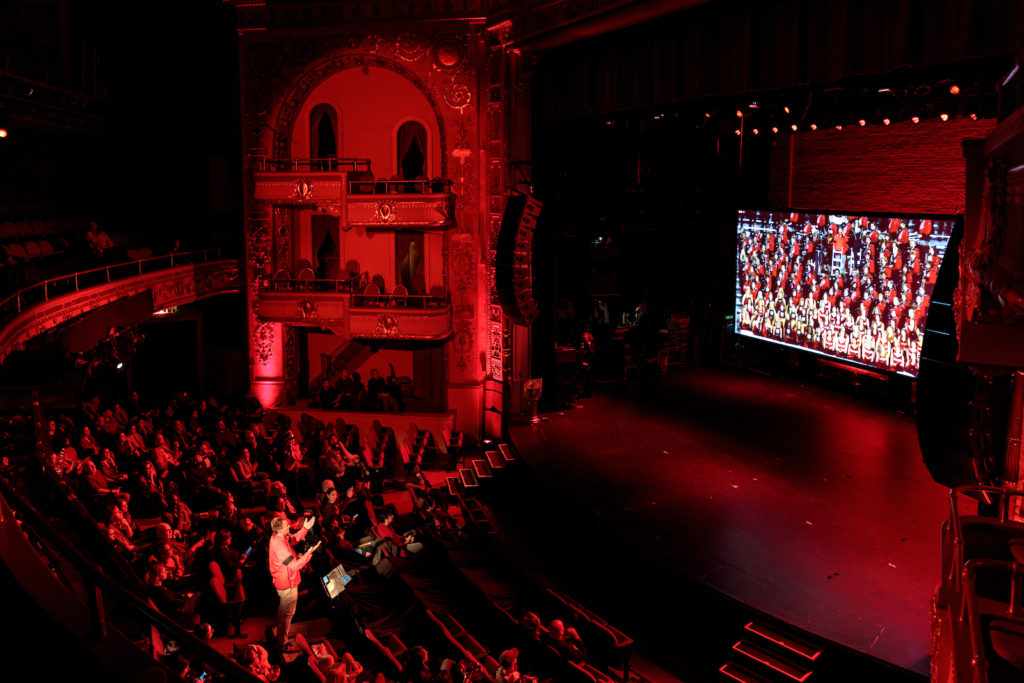
Performa Commission
Co-Commissioned with VIA Art Fund for the Performa 19 Biennial
Photo © Walter Wlodarczyk. Courtesy the artist and Paula Cooper Gallery, New York
PF. Yes. I mean, in some ways, you’re right. And when you say that to be the most generous with it, it’s really like a very research-oriented work. I would say in some ways, so much of it was about the research that was done over three years. It’s hard to separate all of that groundwork from this unique performance that happened just one night.
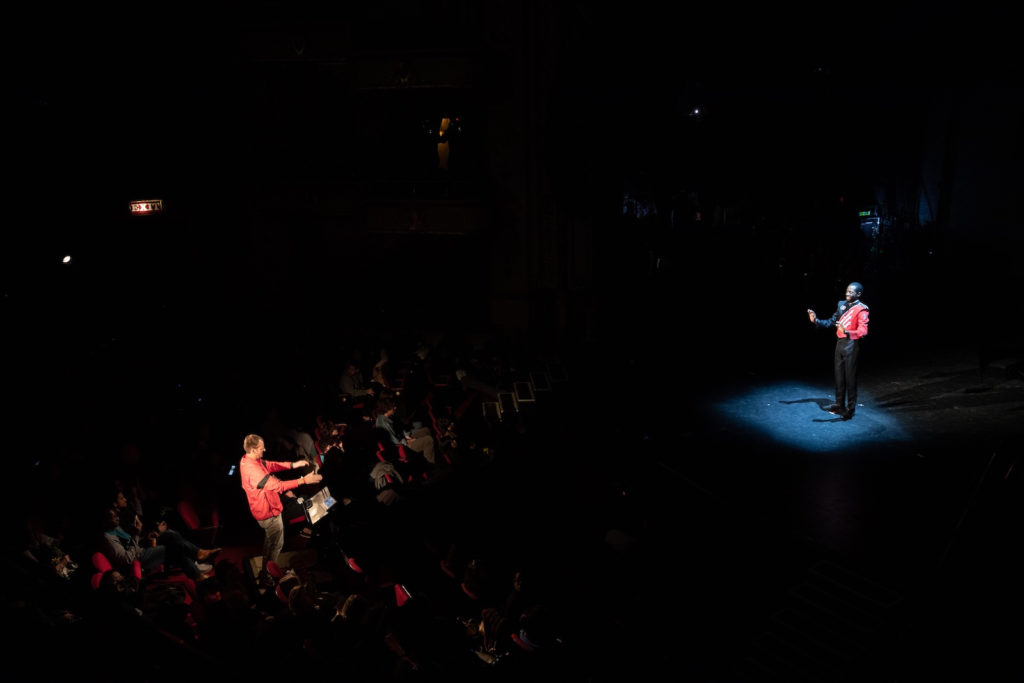
Performa Commission
Co-Commissioned with VIA Art Fund for the Performa 19 Biennial
Photo © Walter Wlodarczyk. Courtesy the artist and Paula Cooper Gallery, New York
And like you said, the reason why it could only happen on one night was because the nature of the band is that they were only available for one night. It took planning for a year to be able to do what we did on that one night. The band is made up of volunteers from the student body of University of Georgia. What they do during the course of a normal football season, they maintain a strict schedule of coming to rehearsals almost daily in the short rest periods that they have between study and classes. They’re like an army, like a machine that it has been honed to a T by the brilliant directors of the band.
I worked closely with my team and with the directors of the band to create the work with their blessing. The director of the band is a really serious scholar of music and he was intrigued by the interest to do something like this, to take what he does every day of the season and to displace it into another context. There was a fascination with what the band does, that was born out of this dialogue with the director of the band. It would not have happened otherwise.
We literally pulled the band from their usual routine for just forty-eight hours. Enough time to for them to get on a plane, and then do the performance, and then get back on a plane and go back to Georgia where they resumed their normal schedule. It was extremely special. They really, in a sense, did it out of the interest of doing it. Really, nobody made money on this. It was purely a kind of experiment done out of interest in the experiment. As careful as we could be, the nature of engaging this machine and attempting to try to make it operate in an alien environment was only partially controllable.
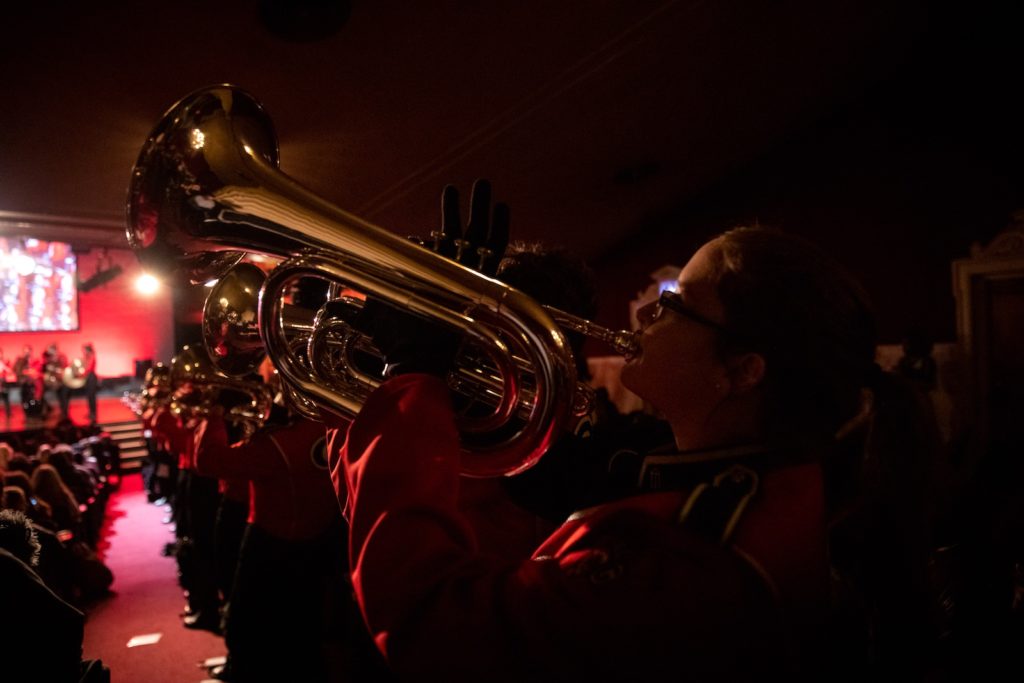
Performa Commission
Co-Commissioned with VIA Art Fund for the Performa 19 Biennial
Photo © Walter Wlodarczyk. Courtesy the artist and Paula Cooper Gallery, New York
I mean, the very idea of having a part of the band in the theater and a part of the band back in Georgia and then attempting to perform together… Really, the game of the event was to see if they could sync via a [live stream] screen. They had a lot of fun attempting to, but the whole situation was designed to make it almost impossible for that sync to occur. Really, it was to increase the likelihood that they would fall out of sync and to really present people with the experience of that out of sync-ness, occurring in real time.
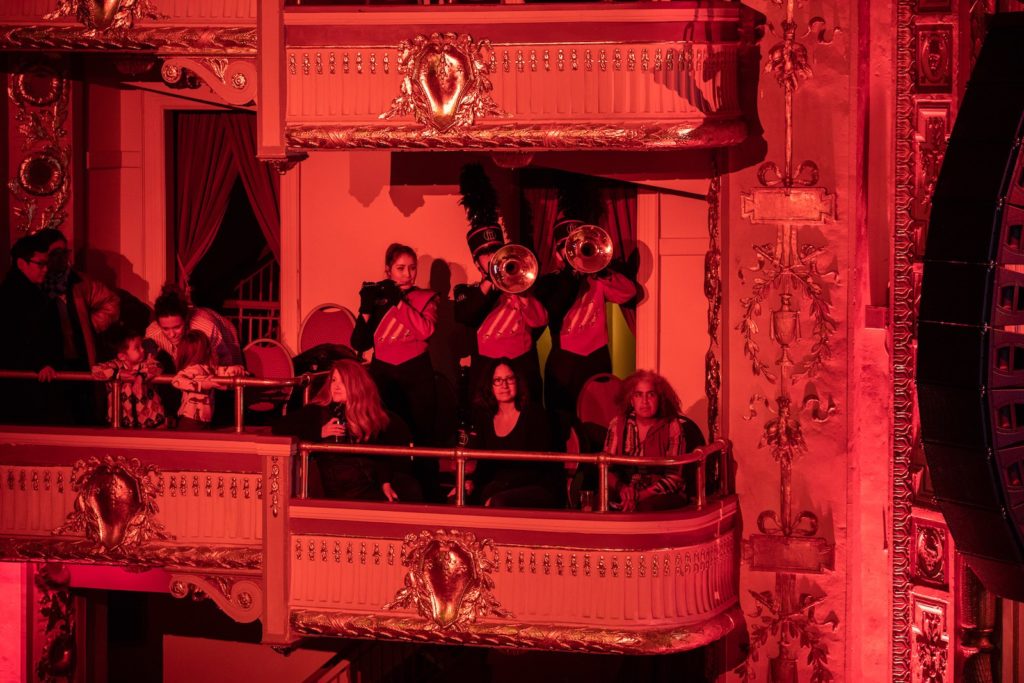
Performa Commission
Co-Commissioned with VIA Art Fund for the Performa 19 Biennial
Photo © Walter Wlodarczyk. Courtesy the artist and Paula Cooper Gallery, New York
None of which was articulated beforehand. It really unfolded as this kind of thing that started with a certain kind of premise that seemed familiar and that increasingly turned into something extremely unfamiliar. I will pull out one thing about it, which is… And it’s a connection to The Saints, the piece that I did in London. After The Saints was shown in the shadow of Wembley Stadium in London, it was then shown at a number of different venues, including at the National Gallery in Berlin, Hamburger Bahnhof.
When it was shown in the Hamburger Bahnhof, it was shown in one of the galleries in one of the wings, in a big open plan room. Very pristine with grid lighting, just very minimal… the strangest possible white box architecture. And then to fill that space with nothing visually, but the sound of the crowd sonically. One of the things that happened, I guess, which I didn’t fully expect, was that the crowd then proliferated association and then reflected the context so that, even though it was designed to be a football crowd, you couldn’t help but hear the crowds of a political rally, simply because of the context of Berlin and the ghosts that it awakened on a sonic level.
Similarly, in the Apollo, there’s a way in which the sound of the band, as a kind of musical formation that has a military point of origin and that usually is played at a certain volume to incite the emotions of a crowd, played in the Apollo really hit people. I know this because of responses. It conveyed a sort of musical tradition, abstractly speaking, having to do with the incitement of crowds in a way that had a very disturbing resonance to it.
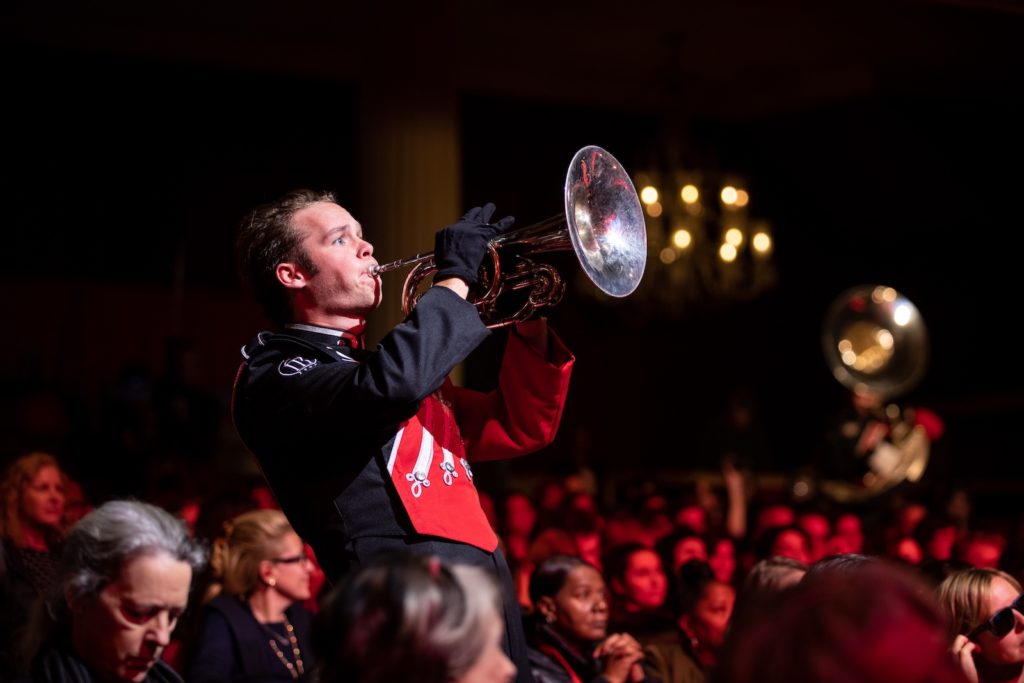
Performa Commission
Co-Commissioned with VIA Art Fund for the Performa 19 Biennial
Photo © Walter Wlodarczyk. Courtesy the artist and Paula Cooper Gallery, New York
BL. I think you said that when the national anthem was played, people stood up.
PF. People stood up. Remember, this is an art world audience. From backstage, I could see some people put their hand over their heart but then look around and then take their hand off their heart. I saw a lot of awkwardness. I mean, there wasn’t meant to be a “got you” about any of this. In fact, we really took great pains to make sure that there was a sense of no one being purposefully turned into an image or being excluded from the game that was being played.
But then despite that, I think there were questions that were left about what people took away from it. I think that there were some genuinely disturbed feelings. I remember talking to one of my students about it, asking what they thought. And they said, “Well, it’s spectacular but in some ways, it’s a marching band so, of course, it’s going to be spectacular.” And so that were to discredit the effect of the fame, of the performance.
I think what my student meant, or what I think he was trying to say is, you couldn’t help but be fascinated by a certain entertainment value that was happening. But then, that’s exactly what we are supposed to avoid doing as artists perhaps. And there’s a way that you could point to the entertainment factor as almost like the line in the sand between poetic utterance versus propaganda.
In this case, there was a purposeful play with the language of propaganda to open it to a kind of questioning or with an attempt to open it to a poetic ambiguity. But then, to play with that distinction is in itself a challenge, I think.
BL. I know you’re not quite sure what phase two of the work will be, perhaps an installation. Where are you going to take all this? And as an installation, perhaps it will open at the Paula Cooper gallery?
PF. Well, we’re still looking into it. I will say, this Performa commission comes at a particular moment. Since the late nineties, I’ve been playing with video, and the technology has changed over the twenty years, right? Dramatically so. Like all other artists, I’m attempting to account for these changes, even as I’m looking to stay in the conversation creatively and intellectually, and contribute to it.
So, all of this just to say that what interested me about the Performa commission, at this particular juncture of my own development as an artist, is that I find performance an interesting thing. And obviously, it’s not just me. I think there’s more and more a kind of important dialogue around the nature of performance in the art world. The way that I would put it, for me personally what’s interesting about performance is that it relates to discourse that has come before this moment from theorists like Judith Butler, among others.
What sticks out for me in what Judith Butler says about performance is that performance could be seen as something that happens on the stage. Or you could widen the perspective and see performance as something that doesn’t necessarily happen on a stage, which in a way goes unnoticed in daily life. There’s this way in which performance can both refer to something very specific, and, in a way, an area of specialization, but it can also be used as a metaphor for something that’s much more pervasive and very little discussed.
And that is the extent to which everyday actions and forms of self-presentation constitute a kind of performance in the sense of a fabrication, not something that is just naturally true and exists spontaneously as just purely natural, but something which unconsciously or consciously we develop around a kind of language to present ourselves and subjectivity as something to be received by others. In the era of social media, to me, this is like a really important distinction, because the nature of social media for me is that it represents a really intense and now ingrained way that we circulate via images, which happen in real time and seem to represent reality.
Yet we know from the cautionary tales of everything, from the way Facebook was used to stoke ethnic violence in Burma just a couple of years ago, to the way that Cambridge Analytica came to be recognized in a way for manipulating public opinion on a virtually invisible level, to all the ways that it’s being used now. I mean, we’re back to this primal scene of a certain confusion between the image and the real or the representation and reality.
BL. In an interview of yours, I read you look back to Ralph Ellison’s 1942 novel, The Invisible Man. You said you feel part of our problem is that race is usually constructed as a special area of inquiry, separate from the main subjects. I thought it was an interesting metaphor for how we live in an image-based culture, not just in terms of race, but in terms of identity and how we come to understand ourselves through images, which in some ways are stereotypes about ourselves. Yet there is no other way to understand ourselves. I’m wondering, what do you think about images being synonymous with who we are?
PF. That is one of the most slippery questions ever, and I like it. I appreciate the question. I will start by saying that I don’t claim to have invented this or to have originated this idea. I do think that, in some ways, what we call the American political sphere seems to be very much defined by a logic of identity politics. The issue for me now is that, unlike the early 2000s, the proliferation of images in real time that comes with the rapid development and deployment of social media really changes things.
I don’t think that it erases this dynamic of a certain confusion between subjecthood and image/self-image. I think that’s still very much the case. In some ways, I feel like it’s gone through further evolutions to where that confusion is all the more thorough—in this particular moment with the death of George Floyd and the protests that have come about afterwards, even just this week with the outpouring of solidarity statements.
What I can’t help but think of as definitive of this moment is something I experienced a few days ago, where, within a 24-hour period, I got emails with personal organizational-solidarity statements from everybody from large institutions, like the Whitney, to small institutions and corporations like Lyft and Nike. That juxtaposition, to me, is definitive. This takes nothing away from the specificity of different entities that exist in our cultural landscape and all of the nuances that we can argue over that distinguish one organization from another and one person from another.
But it seems like a structural problem where whatever anybody was saying, from a user-interface perspective, got immediately flattened out and collapsed by the sheer juxtaposition of seemingly personal statements and obviously corporate slogans appearing in the same feed, at the same time, canceling each other out. That, to me, is a bigger problem that, in some ways, subverts any distinction that we could attempt to make individually.
So again, not to take away from any kind of nuance that seems very important to cultivate at this moment. But on top of that, there appears this structural problem of a general flattening out that seems almost irresistible. To me, that describes something even further to what you posed as a dynamic… like all the more thorough blurring of the distinction between the representation and the real.
How we forge a sense of subjectivity or much less independence or agency or autonomy in this kind of environment appears like a huge question. And in some ways, the urgency of it, for me, it must be said, comes from almost a sense of exhaustion that everything seems equally hollow, and yet we know that people are really being killed because of racialized violence that appears to be institutionalized. There’s almost a helplessness about this kind of structural hollowing out of everything, even as it becomes undeniable that there is a really unjust way that people are subject to violence within a racial hierarchy.
It seems all the more real because of the body cam footage that we can’t avoid. And yet it comes simultaneous with a hollowing out that makes it seem almost instantaneously consumable and digestible and unreal as a result.
BL When you work, I know that you have a studio uptown. How do you develop work? You’re teaching—do you have a studio assistant? I’m curious, do you bring in people when you have a big project like what you did with the Performa commission? Do you have people in the studio all the time? Are you there alone? I’d love to know how you work.
PF. You probably know, my background is really printmaking—a pretty solitary sort of medium. Although, I do find it interesting that like video, printmaking has this double identity as an art medium, and also as a commercial medium. It’s used for signage; it’s associated with posters and advertising, both commercially and also in relation to activism. It’s really got these popular roots.
So, to use it, you’re always engaging those populist roots, as well. More and more recently, I find myself wanting to explore methodologies from the world of film production, which is not something I have a background in. I mean, part of that is just via cell phone cameras. More and more, we have these powerful tools associated with film production right at our fingertips.
It just seems that’s got to be something to explore, but then, that bigger context of film production and the way it’s used to promote ideology, or just consumer products seem more and more pertinent these days. I generally work in a project-based methodology, where I purposefully try to limit the project through a decision about the duration and the budget for a project. What I think filmmaking allows for is to think situationally. It’s possible to bring together a team for a specific project that could be made up of any number of kinds of people, including non-art world people.
In a sense, under the premise of a project, you could get fully situational and formulate a provisional set of relationships that are necessary to complete a goal among the most unlikely sorts. The ability to, in a way, play expansively in this way that traverses the symbolic realm of art and the real world of people’s lives outside of the laboratory conditions of a gallery or museum, is what’s of interest.
Then how to formulate that so that it can be articulated and accessible as an art project is another story. In some ways, I feel like the first step is to formulate a playing field that allows for a kind of free play in a focused way. To be the object of focus, in a way, here is that increasingly unstable boundary between the symbolic and the real.
BL. I imagine in the last three months of the Coronavirus 19 lockdown, you were doing a lot of planning.
PF. As we all are, right? I feel like we have to recalibrate with these new shocks to the system that we’re experiencing in real time.
BL. My very, very last question, which I’m asking all my guests on Barbara London Calling: Do you consider yourself a media artist?
PF. I was thinking about that question. In some ways, the question itself, what it brings to mind is a kind of tension that has existed for a long time around the legitimization of video as an art form. To me, there’s no question, it is. I don’t need to tell you this.
To me, what is exciting about the medium of video as an art form, like performance, is that inherently it is tied to the real world. It has this kind of double identity that makes it a very specific medium to pick up and use. In a way, painting is more simple, or sculpture-making is more simple. But there’s something inherently problematic and, therefore, productive about video or new media in general, which is this ambiguity about its relationship to the production of poetry as a symbolic form and the political uses of the medium in the world.
In a way, it’s inherently tied to a certain tension around these things. On the one hand, the question of whether to consider myself a media artist implies a kind of desire to legitimate video as a worthwhile and valuable art form, and to me, there’s no question about it. But then, to think as forward-looking as possible about this question, I would be in the camp of saying that the vitality of video today has to do with the way that it naturally can extend itself into a conversation about how art as a form of image-making relates to the bigger world of image-making in 2020, which, to me, is an extremely urgent question—one that, in some ways, makes other forms of image production seem to be less intrinsically tied to the necessities and urgency of this moment. I want to feel the excitement and the urgency of doing work that engages the problems of this moment. That’s why I would declare my interest in video or of being a media artist.
It’s no longer about legitimating but about reconnecting art to the urgencies of the world we’re in, in a way that has existed before—and perhaps we lost touch with—but that is extremely necessary now.
BL. That’s a beautiful way to end.
PF. Cool.
BL. Thank you so, so much.
PF. Thank you, too.
This conversation was recorded June 8, 2020, and has been edited for length and clarity.
Support for Barbara London Calling is generously provided by Bobbie Foshay and Independent Curators International, in conjunction with their upcoming exhibition, “Seeing Sound,” which I curated. Be sure to like and subscribe so you can keep up with all the latest episodes. Follow up on Instagram @Barbara_London_Calling and check out BarbaraLondon.net for transcripts of each episode and links to the works discussed.
Barbara London Calling is produced by Bower Blue with lead producer Ryan Leahey and audio engineer Amar Ibrahim. Special thanks to Le Tigre for graciously providing our music. Thanks again for joining us. We’ll see you next time.
Images
Born 1966 in Honolulu, Paul Pfeiffer spent much of his childhood going between Hawaii and the Philippines. In 1990 he relocated to New York, where he attended Hunter College and the Whitney Independent Study Program. In his work, he investigates the relationship between video, sporting events, racial politics, often exploring the world of professional and collegiate sports as a filter through which to understand society and history. He utilizes digital technologies to examine the role mass media plays in shaping contemporary consciousness.

Pfeiffer appropriated and painstakingly processed 5,000 digital frames of televised NBA basketball games for this distinctive work, removing the presence of basketball players on the court and leaving only a palimpsest of their hands. The absence of athletes repositioned what he calls “the spectacle and spectatorship,” centering the viewer’s attention on the gravity-defying basketball as it mysteriously floats in midair. He intensifies the visual experience by reducing the scale of the looped image and presenting it on a miniature LCD monitor connected to a long armature attached to the wall. Installed above head height, the work is best seen by one viewer at a time. Pfeiffer transforms a dramatic public sporting event into a moment of private, almost devotional contemplation.


Seventeen-channel audio, two-channel video loop with stereo audio; single-screen video loop, cast armature with LCD monitor
Installation view, The Saints, Nationalgalerie im Hamburger Bahnhof – Museum für Gegenwart, Berlin, Germany, October 10, 2009 – March 28, 2010.
© Paul Pfeiffer. Photo: Courtesy the artist and Paula Cooper Gallery, New York.

Seventeen-channel audio, two-channel video loop with stereo audio; single-screen video loop, cast armature with LCD monitor
Installation view, The Saints, Nationalgalerie im Hamburger Bahnhof – Museum für Gegenwart, Berlin, Germany, October 10, 2009 – March 28, 2010.
© Paul Pfeiffer. Photo: Courtesy the artist and Paula Cooper Gallery, New York.
Pfeiffer appropriated sounds of the crowd at the famous 1966 World Cup Final between England and Germany—the most famous sporting event ever staged in Britain. He mixed the audio of the cheering, chanting and praying crowd with voices from a group of boisterous young Filipinos, who chanted and cheered their way through the 1966 soundtrack. Played through a large constellation of speakers, the sound installation became a phantom spectacle. At the far end of the Saints installation is a tiny LCD screen, which shows a lonely hero of the 1966 event who lopes around the field without his team, without a ball, and without the trophy. The incisive moment exposes the meaning of hero and myth.




Performa Commission
Co-Commissioned with VIA Art Fund for the Performa 19 Biennial
Photo © Paula Court. Courtesy the artist and Paula Cooper Gallery, New York

Performa Commission
Co-Commissioned with VIA Art Fund for the Performa 19 Biennial
Photo © Paula Court. Courtesy the artist and Paula Cooper Gallery, New York
Between 2016 and 2018, Pfeiffer was the Lamar Dodd artist in residence at the University of Georgia, in Athens, Georgia, a school known for its all-star football team. Instead of focusing on the renowned athletes, he concentrated on the Redcoat Marching Band, highly accomplished musicians he calls the “sonic amplifier of crowd affect and ritual” of football games. Pfeiffer’s research culminated in an unusual performance at the Apollo Theater in Harlem, with a live stream from Sanford Stadium, University of Georgia, Athens. On November 11 (Veteran’s Day), a rare, no sports day in the stadium, fifty Redcoat band members were in New York to perform as they moved through most spaces in the theater; at the same time, a live stream projection on stage showed the other 350 band members at the stadium performing, as they were being recorded by Pfeiffer’s crew. The rousing event, which combined live and virtual performances, created an eloquent statement about society and the forms of control the media makes.


Performa Commission
Co-Commissioned with VIA Art Fund for the Performa 19 Biennial
Photo © Walter Wlodarczyk. Courtesy the artist and Paula Cooper Gallery, New York

Performa Commission
Co-Commissioned with VIA Art Fund for the Performa 19 Biennial
Photo © Walter Wlodarczyk. Courtesy the artist and Paula Cooper Gallery, New York

Performa Commission
Co-Commissioned with VIA Art Fund for the Performa 19 Biennial
Photo © Walter Wlodarczyk. Courtesy the artist and Paula Cooper Gallery, New York

Performa Commission
Co-Commissioned with VIA Art Fund for the Performa 19 Biennial
Photo © Walter Wlodarczyk. Courtesy the artist and Paula Cooper Gallery, New York

Performa Commission
Co-Commissioned with VIA Art Fund for the Performa 19 Biennial
Photo © Walter Wlodarczyk. Courtesy the artist and Paula Cooper Gallery, New York
Between 2016 and 2018, Pfeiffer was the Lamar Dodd artist in residence at the University of Georgia, in Athens, Georgia, a school known for its all-star football team. Instead of focusing on the renowned athletes, he concentrated on the Redcoat Marching Band, highly accomplished musicians he calls the “sonic amplifier of crowd affect and ritual” of football games. Pfeiffer’s research culminated in an unusual performance at the Apollo Theater in Harlem, with a live stream from Sanford Stadium, University of Georgia, Athens. On November 11 (Veteran’s Day), a rare, no sports day in the stadium, fifty Redcoat band members were in New York to perform as they moved through most spaces in the theater; at the same time, a live stream projection on stage showed the other 350 band members at the stadium performing, as they were being recorded by Pfeiffer’s crew. The rousing event, which combined live and virtual performances, created an eloquent statement about society and the forms of control the media makes.
